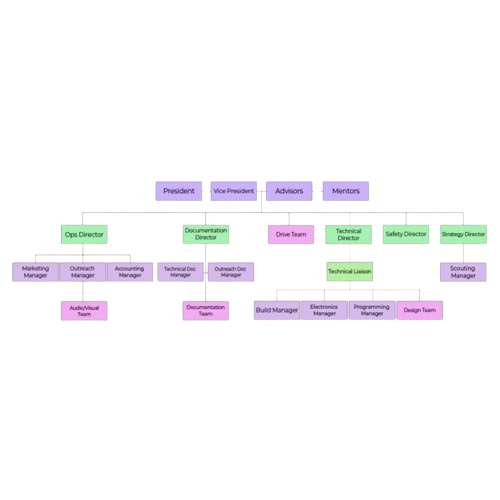
Robotics Team Reorganization
A reorganization of my high school robotics team's leadership and team structure, aimed at streamlining communication and defining a concrete reporting hierarchy
Find more in-depth documentation on my Notion.
.webp)
The Background
During our 2023 competition season, my robotics team, FRC Team 1257, had various communication issues within our leadership team that greatly affected the whole team’s ability to function effectively. All the temporary fixes we attempted before and during the competition season did not hold long-term. Any conflict resolution only dissipated arguments and did not fix broken communication channels.
The Vision
Our team structure had remained unchanged for years, with executive leadership and subteam captains but no hierarchy. However, in 2023, communication issues became so severe that the existing structure broke down. These problems had always existed but were amplified by the leadership dynamics that year. After consulting mentors, team members, and business stakeholders, we decided to restructure leadership. The goal was to redefine roles, introduce new ones, and implement a corporate-style hierarchy to improve communication.
.webp)
.webp)
The Research
After the competition season, we reflected on our off-season plan, including leadership adjustments, administrative tasks, and insights from other teams. This process was a collaboration between the executive team advisor, the team president, and myself as Vice President. I led the effort to define new roles, creating a detailed table outlining responsibilities across three sub-seasons. We also researched successful teams and found they had layered leadership rather than a flat structure like ours. Based on these findings, we decided to model our team after a corporate structure to improve efficiency and communication.
The Development
With a clear vision of the roles we wanted, I created an initial flowchart to visualize the team’s leadership hierarchy and reporting structure. After weeks of discussion, we refined it into a cleaner, more structured version. Using this chart, we established clear reporting lines and adopted business-style role names to simulate a corporate environment. I then developed job descriptions for each role, treating the process as if we were staffing a corporate team. While I didn’t conduct every interview, I played a key role in evaluating all 46 applicants based on skills, leadership, and team dynamics to optimize communication for the next season.
.webp)
.webp)
The Final Product
The 2024 competition season, my final year on the team as President, was the first to implement our new organizational structure. We saw improved communication between Department Directors and Managers, leading to a more productive pre-season where 30 members gained advanced manufacturing skills. During competition season, leadership meetings became more frequent, keeping the team better informed. However, we recognized that communication flowed smoothly partly because senior leadership members were already friends. Since the goal was long-term success, we spent weeks post-season refining the structure, streamlining the hierarchy, and converting job descriptions into more detailed paragraphs while adjusting responsibilities based on what worked. Team reorganization is always adapting to the environment and annual context, but at the very least, I successfully drove the innovation necessary to set the team up for a better chapter in the future.
The Takeaway
At the time, I didn’t look at this process as a project, but now I see it as something with a goal, a development phase, and an implementation phase. During the development phase, I spent every waking hour thinking about how to improve this team because I cared so much about its success. This project allowed me to explore how interpersonal relationships directly impact the functionality of a team. Through that exploration, I learned how the types of people on a team impact the team as much as their technical skills on paper. I have applied this lesson in all my design teams that I have been a part of since this project. I also gained a proficient understanding of business and corporate practices while trying to emulate them in my robotics team. I now have a consistent interest in ordering and organizing teams to improve efficacy and efficiency, which I accomplished to an extent on my robotics team. I hope that my system will be used indefinitely in the future, but systems like these always need updating and redesigning based on the types of people on the team, the overall goals of the team, and other outside factors. I am forever grateful for the opportunity to offer my reorganization ideas to a team.
.webp)